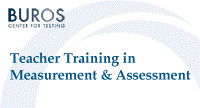Buros-Nebraska Series on Measurement and Testing

Teacher Training in Measurement and Assessment Skills
Date of this Version
1993
Document Type
Article
Citation
Published in Teacher Training in Measurement and Assessment Skills, edited by Steven L. Wise (Lincoln, NE: Buros Institute of Mental Measurements, University of Nebraska–Lincoln, 1993).
Abstract
One of the most common activities in which teachers engage is assessment of students. Stiggins and Conklin (1988) estimated that teachers spend as much as a third of their professional time in assessment-related activities. Although teachers need a variety of observational and problem-solving skills for effective classroom assessment (see chapter 2 by Richard Stiggins in this volume), a substantial portion of classroom assessment activities draws upon teachers' skills in testing and measurement. If they do not have a firm understanding of basic principles of measurement, teachers are more likely to engage in unsatisfactory assessment practices. Hence, a necessary (though by no means sufficient) requirement for effective classroom assessment is that teachers be skilled in measurement.
By and large, the measurement demands being placed on the classroom teacher appear to be increasing, both in amount and sophistication. Curriculum-based assessment, which requires frequent testing of students, is being implemented in an increasing number of schools. Criterion-referenced (i.e., mastery) testing, for which proper use requires measurement knowledge and skills that are substantially different from those needed for norm-referenced testing, is becoming more common. Moreover, recent technical advances in measurement, such as item response theory, are being implemented with increasing frequency in school-based testing programs.
The research base on teacher training in measurement has indicated cause for concern. In the most comprehensive study of this issue to date, Schafer and Lissitz (1987) surveyed the measurement training practices of the American Colleges of Teacher Education (AACTE) member institutions. They found that less than half of the teacher education programs required a formal course in testing and measurement for graduation. Moreover, this is not a newly identified problem. Noll (1955) reported that only 21% of a sample of teacher education programs required a course in measurement. He concluded that prospective teachers' training in testing and measurement is "almost certainly inadequate to prepare them to function effectively in an area so essential to their success as teachers. The situation should be a real matter of concern to all engaged in the work of educating teachers" (p. 90). Apparently, the level of concern has not grown too greatly, given the findings of Schafer and Lissitz (1987) that most teacher education programs do not require a course in measurement.


Comments
Copyright © 1993 by Buros Institute of Mental Measurements. Digital edition copyright © 2012 Buros Center for Testing. This book may be downloaded, saved, and printed by an individual for their own use. No part of this book may be re-published, re-posted, or redistributed without written permission of the holder of copyright.